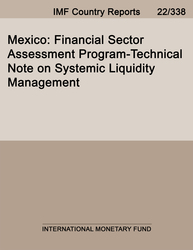
Mexico:Financial Sector Assessment Program-Technical Note on Systemic Liquidity Management
Financial Sector Assessment Program-Technical Note on Systemic Liquidity Management
READ MORE...
Volume/Issue:
Volume 2022
Issue 338
Publication date: November 2022
ISBN: 9798400222733
$20.00
Add to Cart by clicking price of the language and format you'd like to purchase
Available Languages and Formats
| English |
Prices in red indicate formats that are not yet available but are forthcoming.
Topics covered in this book
This title contains information about the following subjects.
Click on a subject if you would like to see other titles with the same subjects.
Banks and Banking , Finance , Investments and Securities-General , Money and Monetary Policy , International - Economics , development bank , Banco de México , standing liquidity , ELA framework , liquidity support , government bond bond market , Liquidity , Lender of last resort , Collateral , Commercial banks , Securities , Global
Also of interest
Summary
Mexican money markets are well-regulated and function efficiently, with significant mitigants to systemic liquidity risks. This is supported by the dominance of the repo market in system-wide liquidity management, the marginal level of interbank unsecured transactions, as well as commercial banks’ full compliance with the Liquidity Coverage Ratio (LCR). However, development banks are not subject to liquidity regulation. These banks have development objectives and the sovereign backstops their capitalization and explicitly guarantees all of their liabilities, however, some of them have a significant reliance on short-term funding with low levels of unencumbered high-quality liquid assets. This might contribute to systemic liquidity risk during periods of extreme market stress in severe tail risk scenarios. Thus, the authorities could consider steps to strengthen the development banks’ liquidity risk management framework by improving the monitoring of their liquidity, leveraging their internal risk committees to take stock of their risk profile and contribution to systemic risk, making use of Pillar 2 requirements, and/or devising appropriate action(s) to improve these entities’ maturity transformation.
Copyright © 2010 - 2026
Powered by:
AIDC



